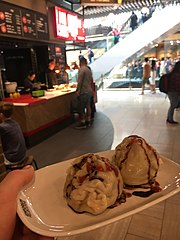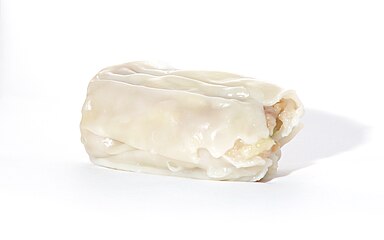Dim sim
 Fried and steamed dim sim | |
| Type | Dumpling |
|---|---|
| Course | Appetiser or snack |
| Place of origin | Australia |
| Serving temperature | Hot |
| Main ingredients | Meat,cabbage |
| Variations | Vegetarian (assorted fillings) |
Adim simisChinese-inspired meat and vegetable dumpling-style snack food, popular in Australia[1]and to a lesser extent in New Zealand. It was popularized in the 1940s, by a Chinese immigrant in Melbourne who originally came fromGuangdong,William Chen Wing Young, the father of Australian celebrity chef, author and TV personalityElizabeth Chong.[1]The name derives from the pronunciationdiim syiim(Điểm tâm) inToisanese,the predominant dialect spoken at the time by Central Melbourne's Chinese community.
Description
[edit]The commercial snack food normally consists of minced meat, cabbage, and seasoning, encased in a wrapper similar to that of a traditionalsiu maidumpling.[2]They are typically cylindrical, or sometimes a larger, globular shape. They can besteamedordeep fried,and are commonly dressed or dipped insoy sauce,tomato sauceorsweet chilli sauce.An alternative way of cooking dim sims is to barbecue them, by cutting the dim sim in half lengthwise and placing on a hot barbecue. A barbecued dim sim is known as a "Moe Crayfish", "Cray" or "Oyster" after the Victorian township ofMoe.Vegetarian dim sims normally contain cabbage, carrot, vermicelli, Chinese shiitake mushrooms or other vegetable fillings, along with seasoning, although these are not generally available in commercial outlets.
Dim sims differ from typical Chinese dumplings in that they are often much larger, have a thicker, doughier skin and are shaped more robustly.[3] They are primarily sold infish and chip shops,[1]service stations, corner shops, and some Chinese restaurants and takeaway outlets in Australia. Supermarkets, some Chineseyum chawholesale outlets and Asian frozen food companies also commonly sell this snack frozen for home cooking. They can also be found at Chinese food outlets in New Zealand.
-
A fried dim sim (South Melbourne style) with soy sauce
-
Steamed dim sim
-
Steamed dim sim
The termdim simdates as far back as 1928,[4]although the modern recipe of the dish most likely was developed inMelbourne's Chinatownin 1945 by entrepreneur William Chen Wing Young for his food processing company Wing Lee.[5][3]The larger, globular version of the dish is commonly known as a "South Melbourne dim sim" due to it originating atSouth Melbourne Market.
Original recipe
[edit]William Wing Young's "original recipe" for the dim sim was presented by Elizabeth Chong on the second episode of the ABC1 TV showMyf Warhurst's Nice(20 June 2012). It consisted of pork, prawns,water chestnuts,spring onions, and soy sauce wrapped in a soft skin-like wrapper.[6]
See also
[edit]References
[edit]- ^abc"Dim sims: The history of a Chinese-Australian icon".ABC News.February 8, 2016.RetrievedNovember 5,2016.
- ^Maggie Hiufu Wong,'What's a dim sim? How an oversized dumpling became an Australian food icon,'CNN News3 August 2021
- ^ab"Dim Sims".Only Melbourne.Retrieved2008-06-25.
- ^James Lambert."Australian National Dictionary Centre".Additions to the Australian lexicographical record III.Archived fromthe originalon 2014-03-01.Retrieved2014-03-12.
- ^"Historyonics: the Dim Sim".Radio National.June 12, 2013.RetrievedNovember 5,2016.
- ^"Myf Warhurst's Nice".Episode 2 - Nice and Tasty.Retrieved2013-11-12.



